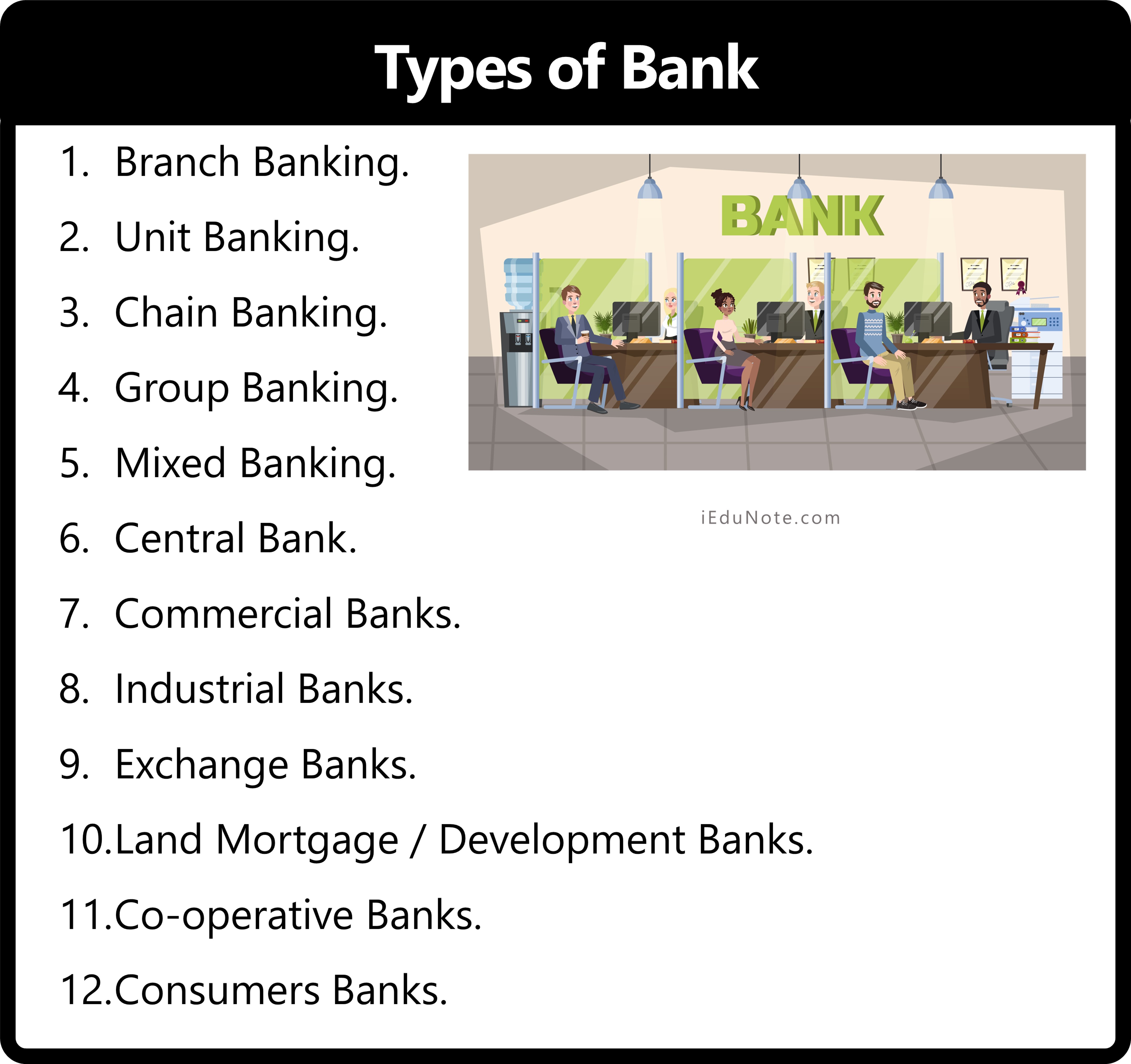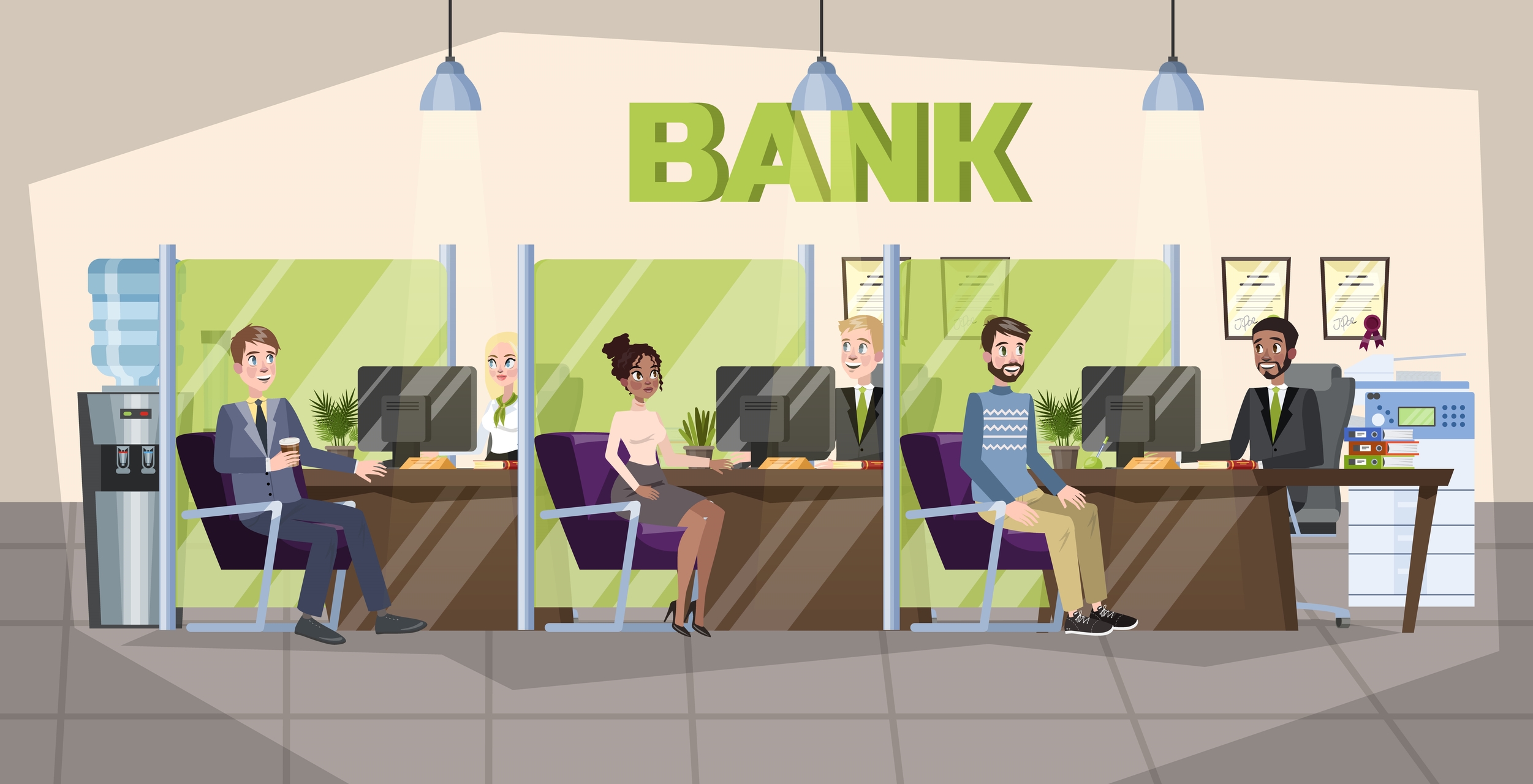Banking is the business conducted or services offered by a bank. In a broad sense, banking is an industry that handles cash, credit, and other financial transactions. Banking can be of various types.
The common 5 types of banking in the USA are; group banking, chain banking, branch banking, unit banking, and mixed banking. But many other types of banking systems are found and practiced in the world.

In the real world of global banking, there are 12 types of banking systems available;

1. Branch Banking

Branch banking refers to a bank connected to one or more other banks in an area or outside. A single bank operates through various branches in a city or different locations or out of the cities in broad branch banking. It offers a wide array of face-to-face services to its customers.
Services a branch provides include cash withdrawals and deposits from a demand account with a bank teller, financial advice through a specialist, safe deposit box rentals, etc.
13 advantages of the branch banking system;
- Economics of Large Scale
- Spreading of Risk
- The economy in Cash Reserves
- Diversification of Deposits and Assets
- Decentralization of Risks
- Easy and Economical Transfer of Funds
- Cheap Remittance Facilities
- Uniform Interest Rates
- Proper Use of Capital
- Better Facilities to Customers – Better Banking Services
- Contacts with the Whole Country
- Uniform Rates of Interest
- Better Training Facilities for Employees
8 disadvantages of the branch banking system are;
- Difficulties of Management. Supervision and Control.
- Lack of Initiative.
- Monopolistic Tendencies.
- Regional Imbalances.
- Continuance of Non-profitable Branches.
- Unnecessary Competition.
- Expensiveness.
- Losses by Some Branches Affect Others.
I explained the branch banking system with its advantages and disadvantages in a separate article in detail.
2. Unit Banking

Unit banking refers to a bank that is a single, usually small bank that provides financial services to its local community. A unit bank is independent and has no connecting banks — branches — in other areas.
Banking systems encourage small, independent banks or banks that are theoretically independent but are owned by a bank holding company.
12 advantages of unit banking are;
- Local funds for local people.
- Intimate Knowledge of Customer.
- Efficient Management supervision and control.
- Discontinuance of inefficient branches.
- Better Service.
- Close Customer-banker Relations.
- No Effects Due to Strikes or Closure.
- No Monopolistic Practices.
- No Risks of Fraud.
- Closure of Inefficient Banks.
- Local Development.
- Promotes Regional Balance.
9 disadvantages of the unit banking system are;
- No Economies of Large Scale.
- Lack of Uniformity in Interest Rates.
- Lack of Control.
- Risks of Bank’s Failure.
- Limited Resources.
- Unhealthy Competition.
- Wastage of National Resources.
- No Banking Development in Backward Areas.
- Local Pressure.
Please read our article on the unit banking system’s advantages and disadvantages for a deeper understanding.
3. Chain Banking
Chain Banking is a form of banking when a small group of individuals controls three or more independently chartered banks.
The underlying principles of chain banking are:
- A small group of persons owns and controls some independent banks
- Each bank carries out its operations independently without any external interference by any holding company.
- Every member of the chain retains its independent identity.
Conceptually, chain banking refers to a form of bank governance that occurs when a small group of people controls at least three independently chartered banks.
Usually, the controlling parties are majority shareholders or the heads of interlocking directorates. Chain banking as an entity has declined with the surge in interstate banking.
Chain banking is when a small group of people controls three or more banks that are independently chartered.
The concept of chain banking is different from group banking. The entities involved in the chain bank arrangement remain autonomous and are not owned by a single holding company.
By contrast, the group banking model requires a holding company to own all the banks involved, effectively creating an umbrella under which all the banks operate.
Chain banking is also different from branch banking, where a single banking institution owns all local branches of a bank.
A bank holding company is a company that controls one or more banks but does not necessarily engage in banking itself.
4. Group Banking
Group Banking is a plan offered by banks designed to be used by groups rather than individuals. In Group Banking, the bank will offer incentives such as discounts, lower fees, interest rates, and other benefits not available to individual customers.
Group banking can also provide a more personalized banking relationship for the members if the bank designates one representative, who is generally more knowledgeable about the group’s needs, as the point of contact for all the group members.
A plan offered by banks is designed to be used by groups rather than individuals. A common example is a company plan offered to employees.
Usually, the bank offers incentives such as discounts, lower fees, interest rates, and other benefits unavailable to individual customers.
Group banking members may have access to lower interest rates, fees, discounts, and other perks unavailable to regular account holders.
Group banking can also provide a more personalized banking relationship for the members if the bank designates one representative, who is generally more knowledgeable about the group’s needs, as the point of contact for all the group members.
5. Mixed Banking
Mixed banking is a system of banking where a bank combines both deposit banking and investment banking. In other words, the bank will provide short-term loans for commerce and trade and long-term finance for industrial units.
While this type of banking promotes rapid industrialization, the mixed banking system reduces commercial banks’ liquidity.
Stated differently, it is difficult to pay back the borrowed funds of customers whenever they demand their money. This is because funds get blocked when the bank gives long-term loans to industries.
6. Central Bank

The Central Bank of a country is an institution that leads the banking system and the money market. It regulates money and credit in close cooperation with the government. It also controls the other banks in the country. It occupies a central position in the banking structure of a country.
7. Commercial Banks

Commercial banks accept deposits from the public and grant short-term loans and advances to their customers. They cannot afford to grant long-term loans. Commercial banks also render a variety of agency and general utility services. They finance the internal trade of the country through nearly 66.000 offices.
8. Industrial Banks
Industrial banks are those banks that deal in long-term loans. The finance industries either by granting long-term loans or by subscribing shares, debentures, etc., issued by industrial concerns. They lay a vital role in the industrial progress of the country.
9. Exchange Banks

Exchange banks are banking institutions that finance foreign trade. They are primarily engaged in transactions involving foreign exchange. In this way, they facilitate import and export. Besides dealing in foreign exchange, these banks also undertake ordinary banking business. Most of these banks, such as Standard Chartered Bank, are of foreign origin. Bank of America. City Bank, etc.
10. Land, Mortgage, or Development Banks
These banks raise funds by the issue of long-dated debentures. They specialize in granting long-term loans against agriculture and urban properties for their development. These banks are also known as Land Development Banks.
11. Co-operative Banks
Co-operative banks are registered under the Cooperative Societies Act. They generally give credit facilities to small farmers, salaried employees, small-scale industries, etc. Co-operative Banks are available in rural as well as urban areas. The functions of these banks are just similar to commercial ones.
12. Consumers Banks
Consumers bank is a new addition to the existing type of banks. Such banks are usually found only in advanced countries like the USA and Germany. The main objective of this bank is to give consumers loans to purchase durables like Motor cars, television sets, washing machines, furniture, etc. The consumers have to repay the loans in easy installments.
Conclusion

Various types of banks operating in the world economy meet the financial requirements of different categories of people engaged in agriculture, business, profession, and more. Banking may be defined as accepting a deposit of money from the public for lending or investing investment of that money that is repayable on demand or otherwise and withdrawn by cheque, draft, or order.